Periodically, you read about someone or someones who has been to every country in the world, which means they have been to about 195 countries. Then what?
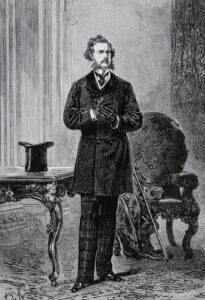
In another context, I had that feeling when I visited Alaska. This was the fiftieth and last State of the US that I visited. I had also visited Puerto Rico. The rules about visit legitimacy was that you stay overnight or have a sit down meal in the State. COVID-19 has made it difficult. I remember Stephen Fry travelled through all the US States in 2007 and 2008. Although it seemed an exercise in continuous Phileas Foggery, his trip was broken into two segments because he had fractured his arm badly, which required stabilisation by inserting ten screws, and the reason there “being a break” between the two segments.
The history of my involvement was that when I found one day by counting off the States I had visited, it came to 35. This had been helped by the Australian Medical Association, my employer at the time, sending me on a field trip to the USA in November 1982, and I criss-crossed the country. The point was that I stayed in various places assigned by my US hosts for a number of days rather than it being just a whistlestop tour.
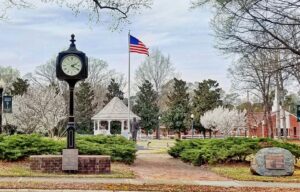
One place I stayed for several days was Roanoke Rapids in one of the poorest areas of North Carolina near the Virginian border. This was tobacco growing country. When I visited there in 1982, Michael Gilstrap had recently been appointed chief executive to clean up the hospital, since it was evident from only a superficial look at the records, that the hospital’s clinical standards were appalling. We got on very well. As I was departing, having to drive back to Raleigh to catch a plane, he said he hoped I could come back for a pig-pickin’. I think we communicated once or twice. He retired in 2005 from the hospital there. I never went back for that pig pickin’.
But back to the main thread. After I reached 35 states, I made the decision to go for the “big five-o”. Fortunately, at the time, we had friends living in Denver, which was a useful launching pad for the prairie and mountain States, which have all contributed to my wellspring of anecdotes. Many of my visits were made before Trump. It is so sad to see how destructive his influence has been, since a sober USA is a crucial bulwark for this planet’s survival.
By the way, I have been to 93 countries – less than halfway. Give it a C+?
A Missive from Massachusetts
I found this following article from the Boston Globe such that if you have not seen it, it emphasises how abundant is the smog of misinformation, which continues to pile up. After all, despite the trolls of Big Business, there have been inroads into cigarette smoking. So, if the community has the will to diminish the amount of carbon in its lungs through the reduction of cigarette smoking, why can’t it achieve the same with atmosphere?
 Boston was in the national spotlight last week as Prince William and Princess Kate travelled to the city. They were in town for Friday’s glitzy Earthshot Prize ceremony, where William’s foundation awarded cash prizes to five companies deemed to have hatched innovative climate solutions.
Boston was in the national spotlight last week as Prince William and Princess Kate travelled to the city. They were in town for Friday’s glitzy Earthshot Prize ceremony, where William’s foundation awarded cash prizes to five companies deemed to have hatched innovative climate solutions.
It was perhaps the most star-studded climate event in Boston’s history. A-listers like David Beckham and Shailene Woodley attended, and pop star Billie Eilish performed remotely. Can all that celebrity really drum up support for the climate fight? That’s the question Globe reporter Sabrina Shankman explored in a piece last week.
Prince William said he chose to host the glamorous Earthshot event in Boston partly because it’s a climate leader. “Your universities, research centres, and vibrant startup scene make you a global leader in science, innovation, and boundless ambition,” he said.
Of course, there’s still much work ahead on the climate front in Boston and Massachusetts. How it gets done will depend in large part on what technologies officials choose to adopt.
A blockbuster story examined a peer-reviewed paper from University of Massachusetts Lowell researchers that touted the benefits of one emergent technology, green hydrogen.
The authors said the state should consider adopting the fuel, using it to heat homes and fuel appliances. But the research was partially funded by gas interests — something the authors failed to disclose.
Making matters even more complicated, recommendations similar to the authors’ wound up in a bill before the Legislature, suggesting that the study could influence state policy despite many experts’ concerns about green hydrogen.
The story shows that the path to meeting renewable electricity targets will likely entail many fights over what should count as “clean” energy.
Another highly controversial energy source: biomass, or fuels derived from wood products and other plant material.
Biomass was eligible for state clean energy subsidies in Massachusetts for years. But the tides have changed for the energy source, in large part because of pushback from advocates, as well as research that shows it can be even more polluting than coal.
In August, officials agreed to strip renewable subsidies from biomass. And last week, the state dealt a blow to a bitterly contested proposal to build a biomass power plant in Springfield, upholding a decision to revoke a key permit from the facility. Technically, the plant could still get built, but that seems unlikely.
As they celebrate that decision, environmental justice groups are criticizing another one: A state body granted the utility Eversource permission to circumvent permits needed to build a highly contentious electrical substation in East Boston. Substations, which convert high-voltage electricity to a lower voltage so it can be distributed to homes, are an essential part of the grid. But opponents say this one is unnecessary and have criticized Eversource’s plan to build it in a flood-prone area across from a playground.
As the state pursues its goal of rapidly slashing carbon emissions from energy, we’re sure to see more fights over where to place new infrastructure.
Makes one depressed! But that is democracy at work.
Malta – The one that did not get away
The year was 2007. One of the places where we were accidental tourists was Malta. Flying from Tripoli in Libya by Air Malta meant that one way or another we could not avoid Malta. Not that it was a real consideration, as we had booked well in advance to visit the Hal Saflieni Hypogeum in Valetta.
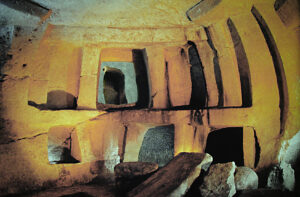
We had received the intelligence that if we wanted to visit the Hypogeum (“underground” in Greek), we had to book well in advance as only 80 could visit each day. One of the reasons for its survival is that for thousands of years, it was sealed off from the outside world, and the internal humid atmosphere was conducive for its survival, at least until it was rediscovered in the late nineteenth century, when there was a move to construct new buildings above it on the same site. Fortunately the Hypogeum was saved, but the early preservation of artefacts in particular was not very good. One of its functions was to be a cemetery, and the upper level which is just below the ground surface seems to be dedicated to housing the dead.
Other experts suggest that there may have been an oracle with a dedicated chamber – the acoustics of the chamber were not demonstrated but apparently the sounds are extraordinary, specially if you were the oracle and had learnt how to maximise the sounds. An oracle positioned so that her voice became a sonic boom would define “sacred”.
The Hypogeum is the most complete known neolithic temple with its roof intact. Being underground one enters the temple via a door in a normal suburban Valetta Street. It is not that the temple appears that huge and you can view the middle chamber from a platform. However, this level seems compact as most of the important structures are visible – including the holies of holies, which resembles a sanctuary and although unseen, steps go down to the lower level. The modest entrance and the fact that the visitor can only have a view limited and be able not wander freely through the three levels belie how extensive it is.
Since our visit, there have been improvements made, courtesy of a grant from Norway, Iceland and Liechtenstein to improve climate control. After the experience of Lascaux and other caves where there is evidence of neolithic life, especially where there is vulnerable artwork and where people were once allowed unfettered access, a change in societal attitudes has occurred. Preservation has become the number one priority.
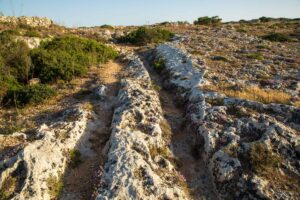
Malta has a number of mysterious prehistoric artefacts. One we walked around in a field outside Valetta is known informally as Clapham Junction (Misrah Ghar il-Kbir) because the intersecting nature of the “cart ruts”, called that because of their resemblance to tracks left by cart. It’s not known for certain how or why they were made. These clearly man-made ruts are dual channels, parallel grooves etched into the limestone bedrock of the islands. The channels, generally shallow, measure between eight to 15 cms deep, but some can be as deep as 60 cms. The width between the tracks extends up to 140 cms, but they are not uniform in all instances. It is very symbolic of Malta being crossroads in the ebb and flow of the Greco-Roman world.
The island has thus been a microcosm of civilisation movements because of its position in the Mediterranean Sea. The island was a staging post for the various groups of Christian adventurers whose aim was to free the Holy Land from Islam. Many of these groups moved with the support of the Church of Rome, the Knights Templar were pervasive across Europe. One of these orders which claims continuity with the Knights Hospitaller, a chivalric order that was founded about 1099 by the Blessed Gerard in the Kingdom of Jerusalem, is the Sovereign Military Order of Malta.
The Order has not only persisted but also has observer status at the United Nations. It has no lands and has a polyglot mixture of people with titles dripping with noble escutcheons. In 1998, a treaty was signed between Malta and the Order granting the upper part of Fort St Angelo, including the Grand Master’s House and the Chapel of St Anne, to the Order with limited extraterritoriality. The Order also has access to two residences in the Vatican.
This treaty was ratified on 1 November 2001. The agreement has a duration of 99 years. The Maltese Government can terminate it at any time after 50 years. In terms of the agreement, the flag of Malta is to be flown together with the flag of the Order in a prominent position over St Angelo. No asylum may be granted by the Order and generally the Maltese courts have full jurisdiction and Maltese law applies.
This is the quirky nature of Malta, with its distinctive Cross that relates to another Order, that of the Hospitallers, who ruled Malta between 1530 and 1798. Malta was always susceptible to invasion, but its resilience during WW11 against the Germans had it awarded the George Cross, which is a simple silver cross, unlike the Maltese Cross. It is the George Cross which is on the country’s flag, not the Maltese Cross. Malta was a British Crown Colony from 1813 and 1964 when the country achieved independence.
I asked my wife what she remembered about Malta. She laughed and said being in hotel lounge overlooking the Mediterranean, and me waxing lyrical over a cucumber infused martini.
In fact, we did a great deal of walking around the capital of Valetta and its harbour. There were the esplanades, reminder of the South of France and the narrow, shaded streets reminiscent of North Africa and the open squares which were reminders of Italy. It is picturesque – ecco, the views of the harbour which once housed the British navy and this mediaeval city despite its savage Axis bombing during WW11, reducing parts to rubble is a place to be viewed.
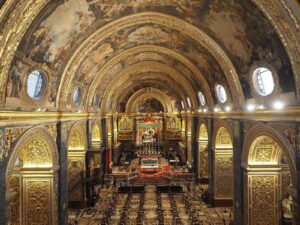
St John’s Cathedral sticks in my mind. The ornate walls, the stunning frescoes – all contribute. But what makes it more than another ornate ecclesiastical masterpiece is the floor of the cathedral. The marble slabs are highly decorated, depicting the coats of arms of each of the knights buried beneath. I know of no other cathedral floor which has such rich inscriptions laid in among the designs. The floor is a polychromatic tableau and yet I remember walking on them with a sense of discomfort. The other sight which stopped me was when I came across the Caravaggio painting which depicted the Beheading of St John the Baptist. Once I became accustomed to the sombre colours of the painting, apart from the blood, it was as gruesome a painting as I have experienced. But this was apparently Caravaggio’s style – to shock. The painting achieves that, and with the ornate beauty of the cathedral, it gave me the creeps – a true example of the Fleurs de Mal, the Baudelaire thesis that at the heart of beauty is evil.
In support somewhat of this Baudelaire observation, in 1607 Caravaggio had sought refuge in Valletta, after beating a man to death in Rome; the Knights of Malta welcomed and knighted him, in return for some paintings—the Beheading of St John the Baptist being one of two which hang in the cathedral.
In the end, for whatever the experience, Malta is unforgettable.
The Martyrdom of Violet Coco
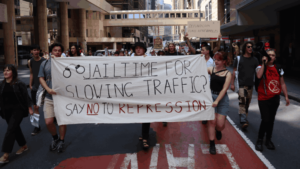 Deanna “Violet” Coco, an Australian climate activist who blocked traffic on the Sydney Harbour Bridge for 25 minutes in April, was sentenced to 15 months in prison on December 2. She won’t be eligible for parole for at least 8 months.
Deanna “Violet” Coco, an Australian climate activist who blocked traffic on the Sydney Harbour Bridge for 25 minutes in April, was sentenced to 15 months in prison on December 2. She won’t be eligible for parole for at least 8 months.
This is how it has been succinctly reported in the overseas media.
This conviction has polarised Australia. The NSW Premier dropped his mask of charm. “If protesters want to put our way of life at risk they should have the book thrown at them and that’s pleasing to see,” he told reporters. The NSW Government recently passed legislation to make unauthorised protesting liable to up to $22,000 in fines and two years in gaol.
In fact Coco did also receive a $2,500 fine for setting off a flare from the roof of her vehicle, which was blocking the traffic.
I have two responses.
From afar, I side strongly with those who believe that her sentence was draconian, and the legislation unnecessary. Close to the action, if I was caught in the resultant traffic logjam, I would have “unspooled” and no punishment could have been enough for the Coco.
Fortunately, the rational overrides the irrational. But does it?
My perspective of protests is nevertheless prejudiced by the nature of the cause driving the protestors. For instance, I have no time for the anti-vaxxers and their conspiracy nonsense. Therefore, my first reaction is for these protesting to be locked up.
The right to protest should be maintained, even though, as in case of Coco, she caused inconvenience. Even if the anti-Coco mob resort to accusations of putting the community at risk by halting traffic, the penalty should be commensurate. In the case of Violet Coco, when compared with the wrist slapping received by the anti-vaxxer conspirators, it is completely over the top.
One of the characteristics of democracy is the right to non-violent protest. Inconvenience is no reason for such a response as meted out to Ms Coco. She may have been an activist in the Fireproof group, but the members are not the violent cowardly thugs that wish to replace democracy by a murderous replica of Nazi Germany whose only aim is to eliminate anybody who wishes to disagree with them, plus a wide array of people of different colour or belief.
The problem is our law enforcement agencies have enough individuals sympathetic with these people to target the Cocos but not the insurrectionist thugs. The current authoritarian bullies who rammed an elderly Danny Lim into a tiled floor, protected by their uniforms, have had their names suppressed. Not arraigned immediately, charged and placed in custody. There is no question of what they did. It was recorded on camera and yet the dissembling by a police force with a substantial basket of dirty linen and over the past fifteen years recruitment to the force of persons with convictions goes on. The police force that nearly killed Danny Lim are the police force that arrested Ms Coco.
The right wing terrorists still stalk the streets, bailed, but can you tell me any of their names? Well, two of them are Desmond Liddington and Maxwell Ferrer. They invaded the home of a left wing activist in November 2021. Mr Liddington also has come to attention since, having rammed a police car in November this year, and is being held without bail. Will his sentence for invasion of this home merit a sentence commensurate with him ramming a police car? They are just two examples, but all their accomplices should be named in Parliament, and their faces grace every police station in the State, even those in uniform to remind us of those who have been employed to protect the Australian democracy have violated that trust. In this way, it reminds all, that climate activists are on the sunny side of the Australian culture.
Release Ms Coco immediately. In fact, between writing and publication of the blog, that has occurred conditionally. She has been bailed.
As the United Nations secretary-general António Guterres said on April 5 this year: “Climate activists are sometimes depicted as dangerous radicals. But the truly dangerous radicals are the countries that are increasing the production of fossil fuels. Investing in new fossil fuels infrastructure is moral and economic madness.”
A set of useful tips?
This is an excerpt edited from The Washington Post:
Jessica Halem adores hotels. And loves to sleep. Unfortunately, the two are often at odds.
As someone with a careful sleep-hygiene routine who must slumber “in complete darkness,” Halem finds herself on the offence during hotel stays. There are tiny lights in the TV and smoke detector to deal with. Gaps in the curtains. Alarm clocks, microwaves, refrigerators, air conditioners. Many devices in hotel rooms emit blue light, which has a more potent impact on sleep than red or amber lights.
“Everything that could possibly be needed … has a light on it, and it’s shining in your eye,” said Halem, 50, an LGBTQ+ health-care expert from Philadelphia. “I can see the lights through my closed eyelids; I know I’m not alone.”
She is not.
Halem has a host of solutions in her tool kit. She brings circular felt stickers — the kind that go on the bottom of furniture — to place over lights, which sometimes involves standing on a bed or chair.
If she can’t turn off an alarm clock, she’ll rip it out of the wall and put it in the closet. She unplugs microwaves and uses the hanger {to hold the curtains shut} trick on the curtains. Sometimes she even tapes curtains to the wall. Multiple eye masks come with her on trips.
She also wouldn’t mind having conversations with “whoever is in charge of the television set that has a red light that doesn’t turn off,” the smoke detector engineers who decided that a green light should indicate the devices are in working order and maybe federal health officials.
“Perhaps the National Institute of Health should get involved,” she said. “There should be some sort of announcement … light leakage is a problem, we shouldn’t have it while we’re sleeping.
Mouse Whisper
“All my life I’ve tried to use music to bring people together. Yet it saddens me to see how misinformation is now being used to divide our world. I’ve decided to no longer use Twitter, given their recent change in policy which will allow misinformation to flourish unchecked.”
Sir Elton John, if you missed it, announced the above last week on Twitter. He is not known to make such a political statement, and while the Musk tried to crawl to him to come back, others have not been that kind to Sir Elton. The nastiness has not altered his resolve.



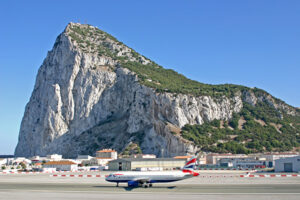
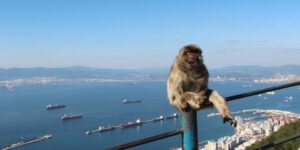
 Over ten years being associated with orchards in the Goulburn Valley made one well aware that after cherries and apricots, the first available Spring fruit was followed quickly by peaches and nectarines and then after Christmas, with berries, came pears and a long tail of various types of apples – and over time there was a shift in the popularity of various types. Peaches were no exception. The prime production of peaches was of the deep yellow clingstone variety which were good for canning, but as fresh eating fruit not as good as the freestone variety. The clingstone although juicy, had skin often difficult to remove. Clingstone peaches are the staple for canned peaches but freestone peaches are becoming more popular. The problem with peaches, which look so attractive, is that such attraction is very ephemeral. Fresh peaches have short shelf life without refrigeration, and it was rare to find them being sold on the roadside.
Over ten years being associated with orchards in the Goulburn Valley made one well aware that after cherries and apricots, the first available Spring fruit was followed quickly by peaches and nectarines and then after Christmas, with berries, came pears and a long tail of various types of apples – and over time there was a shift in the popularity of various types. Peaches were no exception. The prime production of peaches was of the deep yellow clingstone variety which were good for canning, but as fresh eating fruit not as good as the freestone variety. The clingstone although juicy, had skin often difficult to remove. Clingstone peaches are the staple for canned peaches but freestone peaches are becoming more popular. The problem with peaches, which look so attractive, is that such attraction is very ephemeral. Fresh peaches have short shelf life without refrigeration, and it was rare to find them being sold on the roadside.



